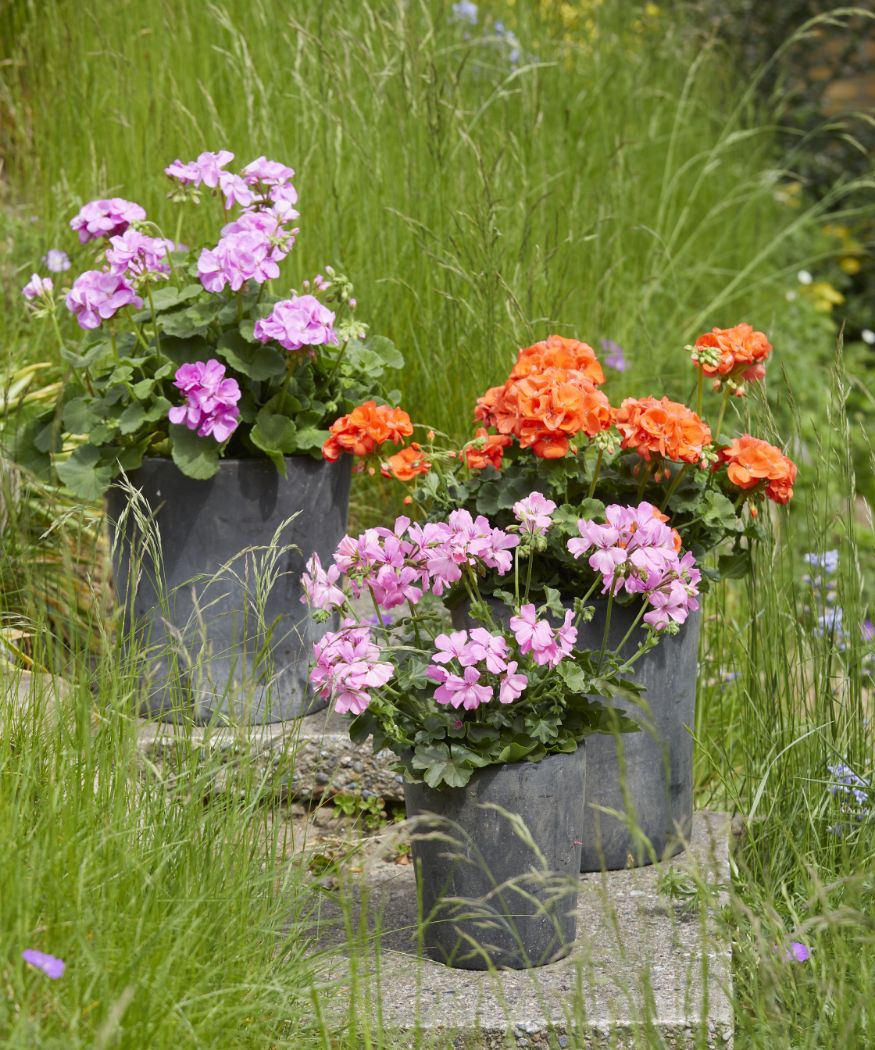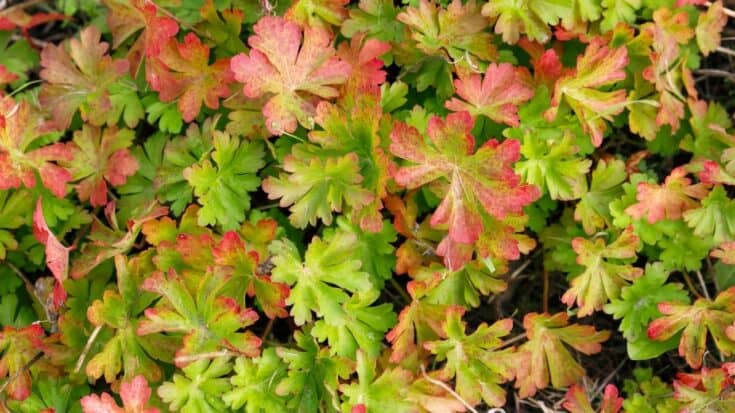People think of geraniums as very low-maintenance summer flowers, and they’re right! But there are four things that geraniums don’t like. If you avoid these things, they will thank you with beautiful blooms.
In this article we tell you what geraniums can’t stand. We’ll tell you how to tell when your geraniums aren’t doing their best and how to take care of them.
With their bright blooms and versatile uses, geraniums are a gardening favorite. But sometimes their leaves inexplicably turn red, alarming plant parents. Is this a sign of problems or just normal adaptation? Read on to learn the science behind reddening geranium foliage and what you can do about it.
Typical Geranium Leaf Colors
Geranium leaves naturally range from light to dark green with slightly reddish undertones in some varieties. The plants produce chlorophyll giving the leaves their green pigment. The shade depends on lighting, temperature, and genetics.
Young seedlings often start off with lighter green leaves. As they mature, the leaves darken. Variegated geraniums feature striking leaves with white, cream, or yellow edges. Overall, vibrant green foliage is the norm during optimal growing conditions.
So when those verdant leaves suddenly flush red, it’s understandable to be concerned Let’s explore the various reasons this eye-catching change can occur
Sun Exposure and Reddening
One of the most common triggers for red tinting on geranium leaves is high light exposure. Remember, these plants hail from sunny South Africa. When sunlight intensity ramps up in spring and summer, geraniums respond by producing anthocyanins.
These pigments act as natural sunscreen to protect the leaf tissue. Anthocyanins absorb and filter excess light wavelengths. They turn the leaves red, purple, or bronze to shield the chloroplasts from sun damage. It’s a clever evolutionary adaptation!
Typical Causes of Reddening:
- Moving a geranium from partial shade into full, hot sun
- Relocating a pot outdoors for summer after indoor wintering
- Seasonal changes bringing stronger light as summer approaches
- Reflective surfaces like white walls bouncing more sunlight onto the leaves
Luckily, this red tinting is harmless. With proper acclimation, the leaves will adjust to the higher light levels. Make sure to gradually introduce geraniums to increasing sun exposure.
Temperature Extremes
Cool weather can also trigger anthocyanin production and reddening of geranium leaves. The pigments help capture and retain heat when temperatures drop. This adaptation protects the plants from chill damage.
Both cold and hot extremes can bring on red pigments, Some reasons leaves may turn red due to temperature include
- Moving plants outdoors before the last frost date
- Exposing plants to cold drafts from open doors or windows
- Intense heat waves or reflected outdoor heat reaching the plants
- Allowing night temperatures to drop too low
Again, this is not necessarily detrimental. But aim to provide average temperatures between 60-75°F for optimal growth.
Nutrient Deficiencies
Lack of certain nutrients can also cause unusual red tinting in geranium leaves. Deficiencies disrupt chlorophyll production and metabolism. The most likely deficient nutrients leading to reddish leaves include:
- Nitrogen: vital for lush green growth
- Phosphorus: aids energy and root growth
- Potassium: regulates water balance and chlorophyll
- Magnesium: helps activate chlorophyll production
Use a balanced fertilizer to prevent nutrient deficiencies. If leaves remain reddish with proper fertilization, try adding more nitrogen-rich options like fish emulsion.
Overly Wet Soil
Since geraniums prefer drier conditions, excess moisture can impact their root function. Wet, compacted soil prevents oxygen from reaching the roots. This stresses the plants, potentially inhibiting nutrient uptake and normal pigment production.
Prolonged saturated soil leads to root rot and other harmful fungal issues. Ensure proper drainage by:
- Adding pebbles or gravel to pots for aeration
- Using free-draining potting mixes, not heavy garden soil
- Allowing pots to fully dry out between thorough waterings
- Eliminating excess water in saucers after 30 minutes
This improves soil oxygen and helps prevent reddish leaves from wet conditions.
Pest or Disease Problems
Various pests and diseases can make geranium leaves turn red, especially issues impacting the root zone. Examples include:
- Root nematodes, which damage root hairs and inhibit nutrient absorption
- Fungal infections like botrytis, which disrupt vascular tissues
- Bacterial wilt or crown rot, which choke off water and nutrients
- Vine weevil larvae, which feed heavily on roots
- Worms and other soil-dwelling pests disturbing roots
In these cases, other symptoms like wilting, spots, yellowing, stunted growth, or sudden collapse may be visible. Treat any suspected pest or disease issue promptly to help restore normal leaf coloration.
Normalizing Reddened Leaves
If your geranium leaves turn red due to environmental factors like sun and temperature changes, no action is required. The pigments help protect the plants from stress. With proper growing conditions, the leaves will rebalance and regain their green hue.
However, red leaves due to underlying problems require intervention:
- Increase shade if sun scalding is causing pigment changes
- Eliminate cold drafts and maintain ideal temperature range
- Apply balanced fertilizer to fix nutrient deficiencies
- Reduce watering frequency and improve drainage for wet soil issues
- Use integrated pest management to counter any root pests
- Apply appropriate organic fungicides to fight disease
- Propagate new healthy plants if the current specimen is too damaged
While red leaves may look alarming at first, they’re often the plant’s natural short-term response to environmental fluctuations. Take time to pinpoint the cause before making drastic changes. With a few tweaks to care, your geranium’s leaves should return to their green glory before you know it!
Geraniums don’t like shade
The more sunlight that falls on geraniums, the more beautiful they bloom. This is because these popular summer flowers belong in the ‘full sun’ category. They collect up hours of sunlight in order to return the favour with abundant flowers and vigorous growth. If there is a lack of light in the shade, they will not bloom as well.
That means your geranium needs more light if it’s not growing much or making new flowers. The leaves will be a pale green colour and you hardly need to water them.

Tips on how to satisfy nutrient needs
Plant your geraniums in fresh, high-quality geranium soil. This is pre-fertilised for the first few weeks. Four weeks after planting, start feeding your geraniums with liquid geranium fertiliser. How often to feed them and in what quantity will be stated on the package.
Or mix a slow-release fertiliser into the soil when you plant your geraniums. This nutrient deposit will probably not be enough for the whole season. Because of this, you should switch to liquid fertilizer if you see that your geraniums aren’t flowering as well or if their leaves turn yellow.
Geraniums don’t like wet feet
As South African plants, geraniums are well-adapted to warm and dry weather. However, they absolutely cannot stand having wet roots. Waterlogging occurs when too much water ends up in the flower pot over a.
long period of time and does not drain off. This can be due to prolonged rain or too much watering. The excess water forces the air out of the soil and the roots rot. If the soil around your geranium is wet, you can tell because water drips out when you lift the pot.
The leaves turn yellow and limp, and the flower stems and roots rot. In severe cases of waterlogging, the potting soil will start to stink. In addition, you will sometimes find blisters on the underside of the leaves.
Tips on how to avoid wet feet
Use clay pebbles or expanded clay to line the bottom of the pot so that any extra water can drain away. Use high-quality geranium soil. It is structurally stable, gives the plants support, and allows enough air to reach the roots. Do not use saucers in which excess water remains. Water your geraniums after checking with your finger whether they need water. The soil should be watered when it feels warm and dry but doesn’t come away from the pot’s edge.
Why Are My Geranium Leaves Turning Red?
Why do Geraniums have red leaves?
Red sky in the morning, Sailors take warning”) gardeners get clues on what’s up with their plants by the color of their leaves. Red leaves on geraniums are a warning to gardeners that the plant is stressed. As pretty as it is to have unexpected colors bounce into your garden, red leaves on geraniums aren’t a good thing. Stress causes discoloration.
Why are my geranium leaves turning brown?
A fungal disease known as geranium leaf rust can cause red or brown lesions to form on the undersides of geranium leaves. This disease is caused by the fungus Puccinia pelargonium-zonalis. Many geranium hybrids are resistant to this condition.
Why is my Geranium turning red in summer?
When your geranium is turning red in summer, this is most likely the cause, although it can happen in other seasons as well. Diagnosing and treating a geranium for water issues is as simple as sticking your finger in the dirt. If the soil feels soggy or wet, the plant is getting too much water.
Why do Geraniums have yellow leaves?
‘Although underwatered geraniums may also have yellow leaves, they will likely have curled edges instead of being limp due to their dry roots.’ Red geranium leaves are more common than you think, but with a few changes to the way you care for the plants, you could avoid the issue altogether.
- The Ultimate Guide to Growing Strawberries in Raised Beds - August 8, 2025
- No-Dig Garden Beds: The Easiest Way to Grow a Beautiful Garden - August 6, 2025
- How to Protect and Preserve Wood for Raised Garden Beds - August 6, 2025

